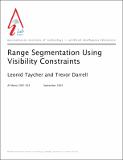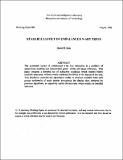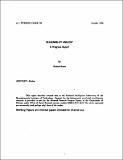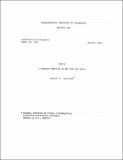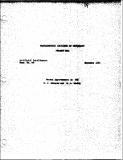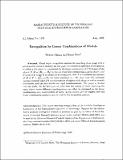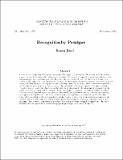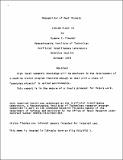Browsing Artificial Intelligence Lab Publications by Title
Now showing items 1307-1326 of 1835
-
RABBIT: A Compiler for SCHEME
(1978-05-01)We have developed a compiler for the lexically-scoped dialect of LISP known as SCHEME. The compiler knows relatively little about specific data manipulation primitives such as arithmetic operators, but concentrates ... -
A Radial Basis Function Approach to Financial Time Series Analysis
(1993-12-01)Nonlinear multivariate statistical techniques on fast computers offer the potential to capture more of the dynamics of the high dimensional, noisy systems underlying financial markets than traditional models, while ... -
RamboNodes for the Metropolitan Ad Hoc Network
(2003-12-17)We present an algorithm to store data robustly in a large, geographically distributed network by means of localized regions of data storage that move in response to changing conditions. For example, data might migrate away ... -
Range Segmentation Using Visibility Constraints
(2001-09-01)Visibility constraints can aid the segmentation of foreground objects observed with multiple range images. In our approach, points are defined as foreground if they can be determined to occlude some {em empty space} in the ... -
Rational Arithmetic For Mini-Computers
(MIT Artificial Intelligence Laboratory, 1977-09)A representation for numbers using two computer words is discussed, where the value represented is the ratio of the corresponding integers. This allows for better dynamic range and relative accuracy than single-precision ... -
Readable Layout of Unbalanced N-ary Trees
(MIT Artificial Intelligence Laboratory, 1986-08)The automatic layout of unbounded n-ary tree structures is a problem of subjectively meshing two independent goals: clarity and space efficiency. This paper presents a minimal set of subjective aesthetics which insures ... -
A Real Time Garbage Collector Based on the Lifetimes of Objects
(1981-10-01)In previous heap storage systems, the cost of creating objects and garbage collection is independent of the lifetime of the object. Since objects with short lifetimes account for a large portion of storage use, it's ... -
Real-Time Part Position Sensing
(1988-05-01)A light stripe vision system is used to measure the location of polyhedral features of parts from a single frame of video camera output. Issues such as accuracy in locating the line segments of intersection in the image ... -
-
Reasoning from Incomplete Knowledge in a Procedural Deduction System
(1975-12-01)One very useful idea in AI research has been the notion of an explicit model of a problem situation. Procedural deduction languages, such as PLANNER, have been valuable tools for building these models. But PLANNER and its ... -
Reasoning Modeled as a Society of Communicating Experts
(1979-06-01)This report describes a domain independent reasoning system. The system uses a frame-based knowledge representation language and various reasoning techniques including constraint propagation, progressive refinement, ... -
Reasoning Utility Package User's Manual, Version One
(1982-04-01)RUP (Reasoning Utility Package) is a collection of procedures for performing various computations relevant to automated reasoning. RUP contains a truth maintenance system (TMS) which can be used to perform simple ... -
REC/8: A CONVERT Compiler of REC for the PDP-8
(1968-01-01)REC/8 is a CONVERT program, realized in the CTSS LISP of Project MAC, for compiling RED expressions into the machine language of the PDP-8 computer. Since the compilation consists in its majority of subroutines calls (to ... -
Recent Improvements in DDT
(1963-11-01)This paper will report new developments and recent improvements to DDT. "Window DDT" now will remember undefined symbols and define them on a later command. Using sequence breaks, it can change the contents of memory while ... -
Reciprocal Interactions Between Motion and Form Perception
(1995-04-21)The processes underlying the perceptual analysis of visual form are believed to have minimal interaction with those subserving the perception of visual motion (Livingstone and Hubel, 1987; Victor and Conte, 1990). ... -
Recognition and Localization of Overlapping Parts from Sparse Data
(1985-06-01)This paper discusses how sparse local measurements of positions and surface normals may be used to identify and locate overlapping objects. The objects are modeled as polyhedra (or polygons) having up to six degreed ... -
Recognition and Structure from One 2D Model View: Observations on Prototypes, Object Classes and Symmetries
(1992-02-01)In this note we discuss how recognition can be achieved from a single 2D model view exploiting prior knowledge of an object's structure (e.g. symmetry). We prove that for any bilaterally symmetric 3D object one non- ... -
Recognition by Linear Combinations of Models
(1989-08-01)Visual object recognition requires the matching of an image with a set of models stored in memory. In this paper we propose an approach to recognition in which a 3-D object is represented by the linear combination of 2-D ... -
Recognition by Prototypes
(1992-12-01)A scheme for recognizing 3D objects from single 2D images is introduced. The scheme proceeds in two stages. In the first stage, the categorization stage, the image is compared to prototype objects. For each prototype, ... -
Recognition of Real Objects
(MIT Artificial Intelligence Laboratory, 1972-10)High level semantic knowledge will be employed in the development of a machine vision program flexible enough to deal with a class of "everyday objects" in varied environments. This report is in the nature of a thesis ...



